
Auckland University of Technology has responded to queries from a media aid watchdog about the future of the regional Pacific Media Centre based at the institution, saying that it remained committed to the centre and would not downplay its importance.
The head of the School of Communication Studies, Dr Rosser Johnson, said in an email to the Australia Asia Pacific Media Centre (AAPMI) on February 26 that “everything that the school is planning will, we believe, enhance its status and increase its visibility”.
He was replying to an AAPMI letter addressed to university vice-chancellor Derek McCormack on February 16 and made public by The Pacific Newsroom earlier this month which appealed for action to save the PMC, saying recent closure of the centre’s physical office came “at a time when Pacific journalism is under existential threat and Pacific journalism programmes suffer from underfunding”.
- READ MORE: Who is killing off top Pacific journalism – and why?
- Concerns grows over PMC after shock office ‘closure’ and no director
- Pacific reaction to ‘end of an era’
- Outcry over signs of upheaval at PMC – Dateline Pacific
- LISTEN to RNZ Dateline Pacific
The centre, founded in 2007 and described by AAPMI as a “jewel in the AUT crown”, had worked in its Communication Studies office in the Sir Paul Reeves Building at the AUT’s city campus since it opened eight years ago.
The office was abruptly emptied in early February of more than a decade of awards, books, files, publications, picture frames and treasures, including a traditional carved Papua New Guinean storyboard marking the opening of the centre by then Pacific Affairs Minister Luamanuvao Winnie Laban in October 2007.
Dr Johnson replied that the school’s “senior leadership team” had decided that the PMC would be relocated from the 10th floor (WG10) to the 12th floor (WG12) of the main Sir Paul Reeve’s building to “bring it alongside the Journalism, Radio + Audio, Public Relations, and Critical Media Studies departments, all of which have had staff actively involved in the PMC in recent years”.
“This move will mean a one hundred percent increase in dedicated PMC office space … and guarantees at least as much space for postgraduate students enrolled in research degrees related to Pacific media topics as there was on WG10,” he wrote.
Puzzled over ‘new office’
However, PMC staff challenge this claim and are puzzled where this “new office” is supposed to be located. One staff member who did not wish to be named said: “Four desks have been put together …essentially. There is no notice or signpost to say where PMC is or if that corner is PMC”.
In the letter, Dr Johnson complimented former director Professor David Robie, who retired in December after leading the centre for 13 years, for his “many years of achievements and unrelenting advocacy of the Pacific within and without AUT”.
He applauded the “excellent work conducted in recent years by a number of students and staff”, including PMC’s Bearing Witness environmental project leader senior lecturer Jim Marbrook and cross-cultural affairs and international collaborations senior lecturer Khairiah Rahman.
Professor Robie himself is critical of AUT’s handling of the transition at PMC and the “trashing” of the old office and its taonga and memorabilia.
He wrote a letter to Dr Rosser in response to the AUT reply to AAPMI on March 5, saying that the school’s approach to the PMC had been “characterised in my experience, by a lack of honesty and transparency”.
He said the success of the PMC had been founded on its “autonomy and the contribution by its cross-disciplinary stakeholders as established initially under the faculty’s Creative Industries Research Institute (CIRI) and continued in the school rather than being located in a silo discipline”.

As outlined in the AUT University Mission Theme 3 directions, he said, the institution had “prioritised social, economic and environmental development” and was especially active in … responding to Pacific communities, and ethnic diversity, and playing our part in its development as a world centre”.
‘Excelled with objectives’
“The PMC has consistently met and excelled with these objectives as demonstrated in the annual reports and research publication metrics,” Dr Robie said.
He also appealed to the university to ensure that the people “who have worked so hard to make PMC successful” would be given a “rightful place in its future directions – they have earned it.”
Some of the PMC’s flagship publications, notably the 26-year-old research journal Pacific Journalism Review and Asia Pacific Report current affairs website, have opted to publish independently of the PMC umbrella.
RNZ Pacific reported on Monday that Dr Johnson had pledged that the “expressions of interest” in the director’s role would be presented to staff this week – three months after Dr Robie’s retirement.
It will be an internal appointment, not a “global” one, as the AAPMI had urged in its letter to AUT last month.
Republished from The Pacific Newsroom.










































